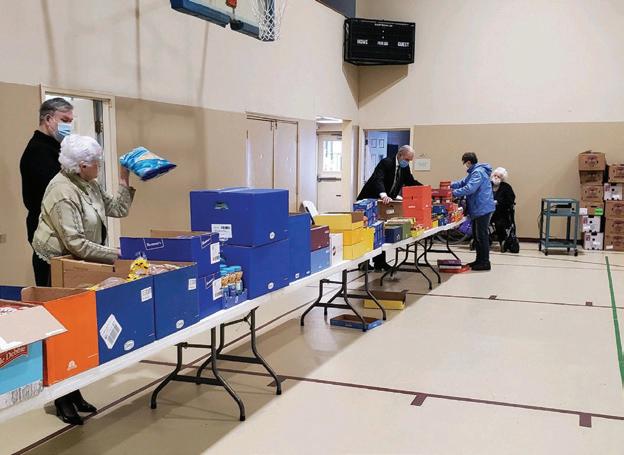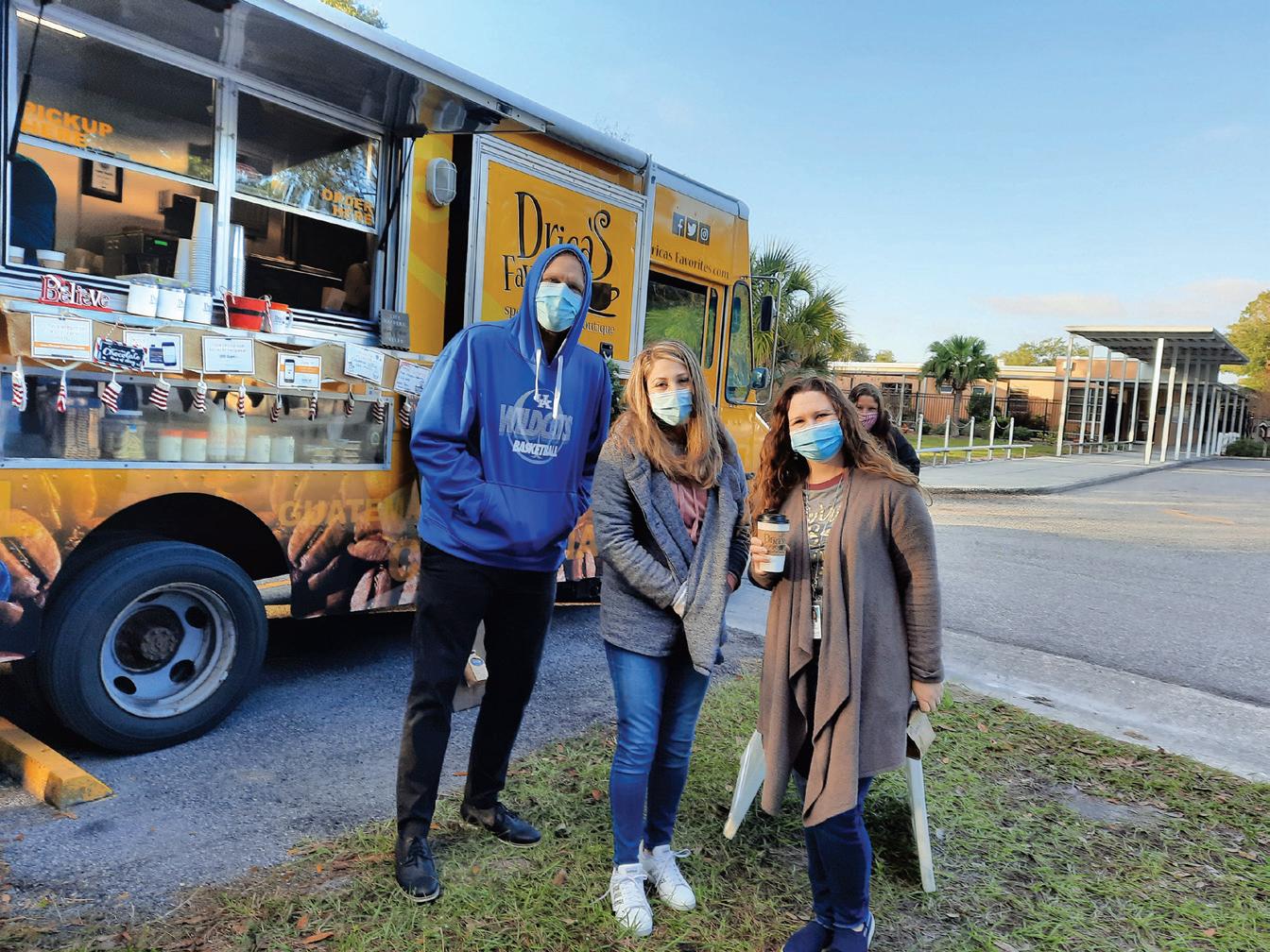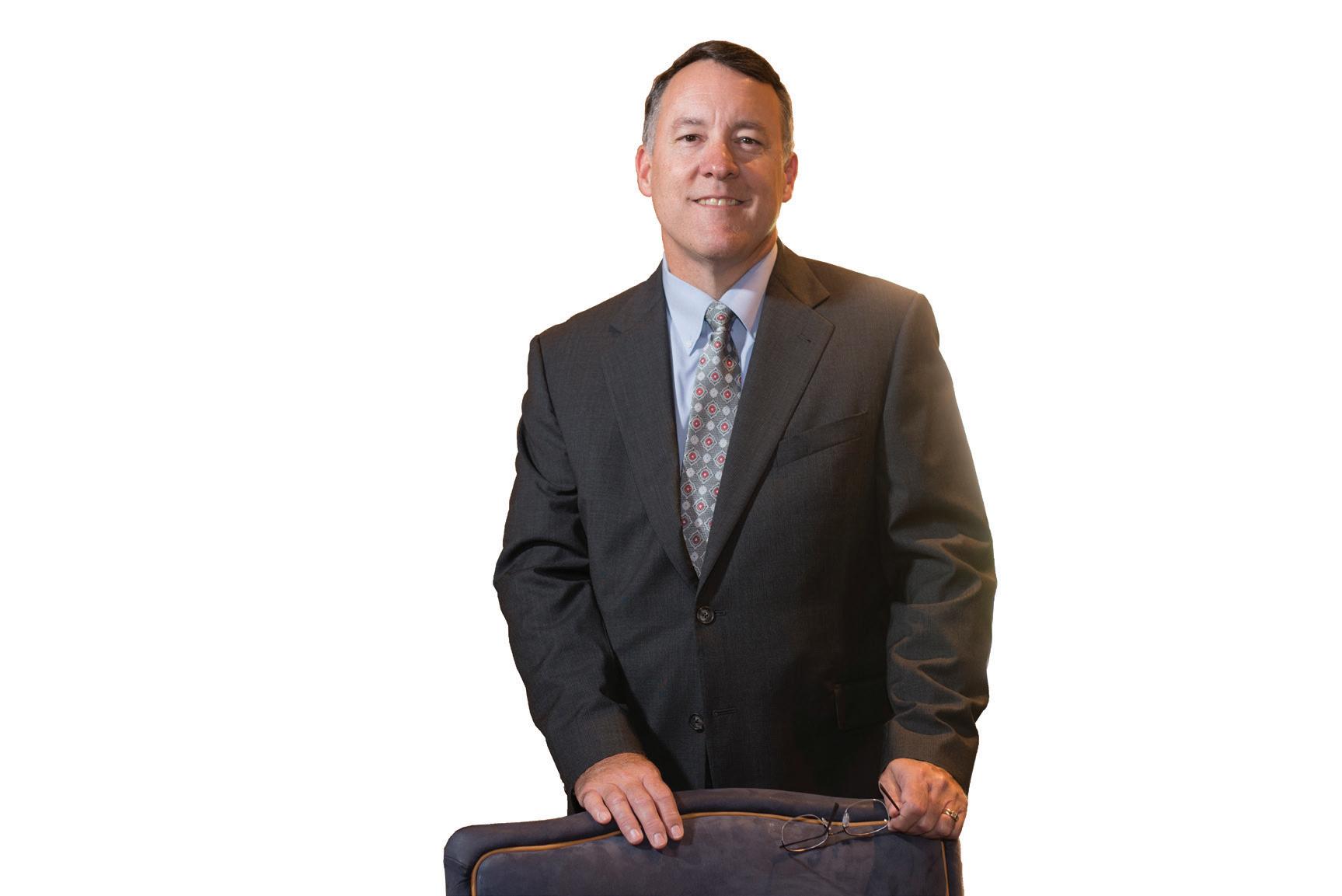
26 minute read
Arbors in Action

70. Marcus T. King, Van Wert Arbor (OH) Sta Sgt. Marcus eodore “Ted” King was killed Dec. 17, 1944, in action in Germany with the 39th Infantry Regiment, 9th Infantry Division. At the time, the units were clearing German forces west of the Roer River. King, 26, had joined Van Wert Arbor three years prior to his death. He was survived by his wife, Mary Helen King; a son, Jerry D. King; parents, Daniel and Minnie King; and one brother and two sisters. He is buried in the Woodlawn Cemetery in Ohio City, Ohio. 71. Earl L. Legg Jr., Kankakee Arbor (IL) Army Pvt. Earl L. Legg, a medic with the 115th Infantry Regiment, was killed Nov. 28, 1944, during the Rhineland Campaign in Germany. Legg was giving aid to a wounded o cer when an enemy artillery shell landed nearby and killed Legg. He was 31 and had been a member of the Kankakee Arbor for more than four years. He was survived by his wife, Maycel Legg of Chicago; his parents, Earl and Alice Legg of St. Anne, Illinois; and two sisters. Legg is buried at Kankakee Memorial Gardens and Chapel Mausoleum. 72. Kenneth Goldsmith, Ottokee Arbor (OH) Seaman Second Class Kenneth Goldsmith was killed Nov. 20, 1944, in the Paci c. He was aboard the USS Mississinewa, a Navy eet fuel ship. It was sunk by a Japanese manned suicide torpedo while the Mississinewa was anchored at Ulithi atoll in the Caroline Islands. Goldsmith is buried at Pettisville Cemetery in Pettisville. He was 19. His father had taken out his rst Junior Policy in 1939, and Kenneth later signed up for a Twenty-Pay Policy with a war clause. 73. Lester E. Aiston, Lulu Arbor (MI) Lester Eugene Aiston, 19, died in action Oct. 24, 1944, during the Leyte Gulf landings in the Philippines. He was a Ship’s Cook ird Class aboard the infantry landing craft LCI-65 when it was hit by a suicide aircraft, one of the rst of many kamikaze planes that the U.S. Navy would face. Aiston enlisted Jan. 11, 1943. He had been a member of Lulu Arbor for seven years, and had worked for E.S. Holtcamp Trucking Co. He is buried at Lulu Cemetery in Ida, Michigan. 74. William W. Turnbull, Ottokee Arbor (OH) Army Pfc. William W. Turnbull was 19 when he was killed in action Dec. 17, 1944, in Germany. Turnbull had enlisted at Toledo only 15 months before. He had listed himself as an actor when he enlisted. Turnbull is buried near his father in Wauseon Union Cemetery in Wauseon. Turnbull had been a member of Ottokee Arbor for ve years, holding a Junior Gleaner Twenty-Pay Policy. 75. Paul Leo Branz, Chatsworth Arbor (IL) Sailor First Class Paul Leo Branz of the U.S. Naval Reserve was killed in combat Dec. 13, 1944, aboard the USS Nashville. e Navy cruiser was assisting with the invasion of Mindoro in the Philippines when it was hit by a kamikaze aircraft. More than 130 sailors were killed. Paul’s father, Ben, had taken out a Junior Gleaner policy for the couple’s son when he was 10. He had been a member with Chatsworth Arbor for nine years when he died at age 19. He is buried in the Chatsworth-Charlotte Cemetery. 76. Harry W. Isham, Wright Arbor (MI) Army Pfc. Harry W. Isham was reported missing in December of 1944 in the Paci c, and six months later was determined to have been killed on Dec. 5. Isham was serving in the Army’s 149th Infantry Regiment with the 38th Infantry Division. At the time, the unit was ghting in Leyte in the Philippines. He had entered the Army on Aug. 9, 1942, in Howell. He was 22 when killed and had been a member of the Society for more than 17 years. He was survived by his mother, Mabel Isham; and a sister, Sarah. His body was not recovered. He is remembered at the Wright Cemetery in Iosco and at the Tablets of the Missing at the Manila American Cemetery and Memorial.
Advertisement
77. Arthur E. Brown, Plattsville Arbor (IL) Army Technical Sgt. Arthur “Art” E. Brown was killed in action Jan. 30, 1945, in the Philippines. He was with Company E of the 129th Infantry Regiment as the unit fought to retake Clark Field and Fort Stotsenburg on Luzon Island. Brown, 24, had received a Junior Gleaner policy from his father at age 12. He was survived by a wife, Alice; and his parents, Frank and Elva Brown. He is buried at Aux Sable Grove Cemetery in Yorkville, Illinois.




78. William R. Brokate, Melvin Arbor (IL) Army Pvt. William R. Brokate was killed March 3, 1945. He originally had been reported missing. Brokate served with Company C of the 253rd Infantry Regiment. Company C fought a three-day battle March 3-5 to dislodge German defenders from the sheer rock cli s and tunnels of a quarry northeast of Bubingen, Germany, one of the last defenses shielding Germany’s Siegfried Line. e company, which lost three-quarters of its troops, received a Presidential Citation. Brokate had been a member of Melvin Arbor for only 20 months, accepting his policy with the war clause. He went overseas Jan. 18, and his last letter home was dated Feb. 22. He was survived by his parents, William and Ann Brokate; four sisters; and three brothers. Brokate was born July 25, 1925, according to his obituaries and was baptized Sept. 13, 1925, although his grave marker at Drummer Township Cemetery in Gibson City, Illinois, lists his date of birth as 1927.



79. Paul W. Valentine, Ottokee Arbor (OH) Army Pfc. Paul William Valentine, 21, of Ottokee Arbor (OH) was killed in action Nov. 15, 1944. He was ghting with Company G of the 19th Infantry Regiment liberating Leyte Island in the Philippines. Co. G was part of the regiment’s 2nd Battalion sent behind Japanese lines Nov. 10-23 to block the Ormoc Road. e road was used to reinforce Japanese “Yamashita Line” strongholds in the jungle-covered mountains. Key to blocking the road was capturing and holding Saddle Hill, which Companies G and E accomplished on Nov. 15, the day Valentine was killed. Although surrounded, the 2nd Battalion kept the enemy supply road closed for a week. at helped U.S. forces break the Yamashita Line, and the battalion was awarded a Presidential Citation. Valentine was born in Morenci, Michigan, and moved at age 13 to Fulton County, Ohio, where he attended Chester eld schools. Some of Valentine’s training occurred at Fort Brady at Sault Ste. Marie before he was transferred to the University of Illinois, enabling him to take leave and visit his parents, R. Ray and Mary I. Valentine. He also was survived by four brothers, Gerald, Howard, Dale and Lawrence. Valentine is buried in Lyons Cemetery, Ohio. 80. Robert F. Stick, Battle Creek Arbor (MI) Army Pvt. Robert F. “Bud” Stick of Company C of the 291st Infantry Regiment died in action Jan. 21, 1945, during the nal days of the Battle of the Bulge. Stick was killed by a sniper at Aldringen, Belgium. A native of Indiana, Stick had moved to Michigan as a child. He had worked at Michigan Carton Co. with his father and uncle. Stick had been insured with the Battle Creek Arbor at age 16. He was 19 when killed. Stick was survived by his parents and one sister. He is buried at Hartford City Cemetery in Hartford City, the home of his maternal grandparents. 81. Lorentz B. Smith, Reserve Arbor (OH) Army Technician Fifth Grade Lorentz Bryan Smith died Feb. 11, 1945, as a result of wounds su ered. He was serving with A Battery of the 387th Coast Artillery (Automatic Weapons) Anti-Aircraft Battalion in the Ninth Army. It was building up along Germany’s Roer River and came under attack from German artillery and a V2 rocket. He is buried at the Netherlands American Cemetery and Memorial in Margraten, Netherlands. Smith was 21 and had been a member of Reserve Arbor for three years, joining while a student at Ashtabula, Ohio. 82. Howard W. Lehrbass, Valor Arbor (MI) Army Sgt. Howard Lehrbass was killed in action during the Battle of the Bulge. He was part of the 87th Cavalry Reconnaissance Squadron’s Troop B trying to block German advances west of St. Vith on Dec. 22, 1944. According to his commanding o cer, “Howard was one of a small group who were guarding the troop vehicles a short distance to the rear of the main line. Large groups of the enemy came into the rear of the line and repeatedly attacked the group guarding the vehicles, the means of escape for those ahead. Never has such a small group fought as well as the group that Howard and one other noncommissioned o cer, were commanding. In the course of the erce ghting, he was hit by small arms re. Despite the immediate medical attention, the wounds proved fatal almost immediately.” Lehrbass was 28 when killed. He had been a member of the Valor Arbor in Scottville, Michigan, for ve years. He is buried at Riverside Cemetery at Custer, Michigan.




83. Arthur William Westerberg, Yellowhead Arbor (IL) Army Sgt. Arthur William Westerberg, 27, was killed in action Feb. 22, 1945, in the Caraballo Mountains of Luzon during the liberation of the Philippine Islands. He was serving with Company C of the 136th Infantry Regiment. Westerberg was born July 5, 1917, in Grant Park, Illinois. He enlisted in April 1942 in Chicago after working in the paint production industry. His father, Charles Arthur Westerberg, was secretary and a founding member of the arbor. Westerberg was survived by his parents, two brothers and a sister. He is buried at Union Corners Cemetery in Grant Park.
84. Franklin B. Hamann, Yellowhead Arbor (IL) Army Sta Sgt. Franklin B. Hamann died Feb. 27, 1945, in England of wounds su ered Feb. 2 while in action in Germany. Hamann was wounded while serving with the 302nd Infantry, part of Patton’s ird Army that had just crossed into Germany and was ghting for control of the Campholz Woods and Sinz. Hamann, 24, was evacuated to a hospital in England where he died. Earlier, on Oct. 13, he had been wounded, but had returned to duty. He was raised in Grant Park and had joined Yellowhead Arbor July 1, 1939. He was employed at the Lions Metal Works in Chicago Heights before his induction Dec. 14, 1942. He was survived by his wife, the former Esther Marie Hunt of Grant Park. He is buried at the Cambridge American Cemetery and Memorial in Coton, England.
85. Allen L. Blackman, Lulu Arbor (MI) Army Pfc. Allen L. Blackman, 22, of LaSalle, Michigan, was killed in action Nov. 23, 1944, in northwestern France. He served with the 409th Infantry Regiment of the 103rd Infantry Division which, on that date, liberated the town of St. Dié. As a Monroe County youth, he had joined the Lulu Arbor at age 17. His mother, Edna B. Blackman, was presented with his posthumous Bronze Star. He is buried in the Erie Union Cemetery in Erie, Michigan. 86. James H. Jones, Port Huron Arbor (MI) Army Pfc. James Henry Jones, 20, was killed Oct. 6, 1944, near Ancy-sur-Moselle, France. He served with the 10th Infantry Regiment of the 5th Infantry Division. It was part of Gen. Patton’s ird Army that was crossing the Moselle River and starting to liberate Metz. Less than three weeks earlier, Jones had sustained a minor wound but returned to action. He had been a member of Port Huron Arbor for three years, attended Keewahdin schools and worked for the Austin Construction Co. He is buried in the Luxembourg American Cemetery in Luxembourg City.
87. Stanley Blackburn Jr., Gravel Creek Arbor (MI) Army Pfc. Stanley Dunn Blackburn Jr. died Feb. 24, 1945, in Luxembourg after being wounded the day before. He was serving with Company M of the 385th Infantry Regiment, part of General Patton’s ird Army. Blackburn was 20 when he died. He was a 10-year member of Gravel Creek Arbor. He is buried at Westlawn Cemetery in North Branch. 88. Daniel J. Taschner, Sebewaing Arbor (MI) Army Pfc. Daniel J. Taschner was killed in action March 5, 1945, with the 379th Infantry Regiment, 95th Infantry Division. On that day it cleared German units blocking a key bridge across the river Rhine at Uerdingen, Germany. Taschner is buried at the Netherlands American Cemetery in Margraten, Netherlands, a nation the 379th helped to liberate. ere also is a memorial in the Blessed Virgin Mary Cemetery in Sebewaing. He was 35 when killed. Taschner had been a member in Sebewaing Arbor for more than 12 years. He was survived by his mother, Catherine, and two sisters.




Look for the nal part of our tribute to Gold Star Gleaners in the Summer 2021 issue of Forum Magazine.





Protecting yourself
body, mind, and spirit
Promoting the health of each member has been a Gleaner priority since the Society’s founding. Over the past year with COVID-19, guarding personal health has created bewildering new health questions:
• Individuals who wondered how long to wash their hands in 2020 are wondering in 2021 about di erent vaccines and new COVID variants.
• Many were forced to trade the mental health bene ts of in-person groups for the mental health risks associated with lockdowns and quarantines.
• Change even came to spiritual health as houses of worship grappled with new building capacity limits and concerns about communion and singing.
e pandemic’s U.S. death toll — about half a million in its rst year — caused hundreds of millions of individuals to re-evaluate how they protect their own health. Not only has this meant fewer handshakes and football fans, it’s a ected the way many of us work, eat, shop, exercise, celebrate, worship, and even grieve. We’ve also seen soaring suicide rates and record deaths due to overdoses as more people su er. Dangers and disturbances call for genuine steps to protect ourselves. Even as we guard loved ones and those at greater risk, we can’t ignore the importance of also protecting ourselves.
e following are a few tips that may help you take action to protect yourself. Remember, your situation may vary, and anyone can bene t from professional help to meet their speci c challenges. For advice speci c to the COVID-19 pandemic, you should consult your medical professionals.

e body is often referred to as the most amazing machine you will ever possess. If you take care of it, it will remain capable for many decades of feats limited only by your imagination. “You are not your own, for you were bought with a price. So glorify God in your body.” — 1 Corinthians 6:19b-20

Watch your weight: A high body mass index (BMI) indicates an increased risk for numerous morbidities that also make COVID much worse. “Obesity is associated with death and disability through its association with diabetes, kidney disease, cancers and then cardiovascular disease, which conveys the highest morbidity and mortality,” Dr. Christos S. Mantzoros, director of the human nutrition unit at Beth Israel Deaconess Medical Center, told the Heart in Diabetes virtual conference in August 2020. “ e same is happening with COVID-19.”


Eat healthy and drink plenty of water: Find ways to eat more vegetables, such as a snack of celery or carrots. Limit your intake of foods high in salt (sodium can elevate blood pressure and increase heart attack risk), sugar and empty carbohydrates (they lead to weight gain) and trans fat (LDL, the “bad cholesterol,” is a heart risk). Dehydration weakens the body, especially as we age. It also worsens our concentration and triggers pangs we may mistake for hunger, causing us to eat unnecessarily.

Step up the exercise: According to the Mayo Clinic, exercise helps manage or prevent many health issues including stroke, high blood pressure, Type 2 diabetes, depression, anxiety, several types of cancer, metabolic syndrome, arthritis, and falls. Becoming stronger helps you sleep better, improves your mood, and provides more energy. If possible, include outdoor activities such as daily walking or bicycling.
Don’t ignore screenings: COVID-19 is not the only health risk. Even during most months of the pandemic, heart disease and cancer have claimed more lives. e American Cancer Society reports a decline in cancer screenings. at could prove costly later as cancer and other diseases are easier to treat if detected early. Ask your physician before canceling appointments. May is Mental Health Awareness Month. Mental health is often tied to conditions causing “deaths of despair” — deaths due to suicide, drug overdoses or alcohol abuse. One study found such deaths rose by nearly 70% between 2009 and 2018. Experts say the situation has grown even worse as the pandemic intensi es isolation, job losses, anxiety and bereavement, plus many survivors’ long-term health impairments. Take active steps to guard your mental health. “Do not be anxious about anything, but in every situation, by prayer and petition, with thanksgiving, present your requests to God. And the peace of God, which transcends all understanding, will guard your hearts and your minds in Christ Jesus.” — Philippians 4:6-7

Accentuate the positives: Many experts recommend writing out reasons why you are grateful. Researchers have found a strong connection between gratitude and a person’s well-being. One study compared acts of gratitude. It found the greatest bene ts came from an assignment to write and personally deliver a letter of thanks to someone who was never given the thanks they deserved. From a single letter, the writers experienced strong gains in happiness that lasted up to a month.
Wish well for other people: Even if you don’t write a letter, mentally wishing the same blessings — peace, joy, love, and freedom from fear or compulsion — for other people as for yourself can increase your well-being. Wishing well for others, even our enemies, reminds us of our interconnectedness and can ease feelings of isolation.
Get enough sleep: Change can wreak havoc on your sleep cycle. It may be tempting to stay up late to binge watch streaming TV shows or to use social media, but protecting your natural rhythm gives your body’s brain time to repair itself. Sleep deprivation also a ects a host of other issues such as overeating.
Make use of help: Seeking help is just as important for improving your mental health as it is for xing your car. (If you or someone you know could use help, write down these resources: 1) Call 1.800.273.TALK to reach a 24-hour crisis center, or dial 911 for immediate assistance; 2) Your physician likely knows of good mental health professionals
in your area who can provide assistance; 3) If you are su ering in a disaster, a free distress helpline can be called at 1.800.985.5990. See more at the National Institute of Mental Health at www.nimh.nih.gov/health/ nd-help.
Your Spiritual Health
Spiritual wellness helps build our values and guides our response to challenges, including pandemics. It gives us a framework for the deeper meanings of this life and what exists beyond it. A spiritual viewpoint should draw us nearer to God and, in the process, nearer to everyone else through compassion, joy, love and forgiveness. “For while bodily training is of some value, godliness is of value in every way, as it holds promise for the present life and also for the life to come.” — 1 Timothy 4:8
Reading God’s word: God’s word is one way we gain spiritual understanding and direction for healthy daily interactions. It also helps us distinguish between what the world calls virtue but what God regards as vice. Bible study with a devotional or a group (even online) can help us grow deeper in understanding the ways God loves us and each person we meet.
Prayer: Bringing our praise, worries and requests to God is a healthy spiritual habit that believers are urged to continue. It reminds us that we are not alone, nor are we ultimately in control. In addition, research indicates that prayer and meditation can help reduce stress, high blood pressure, and other negative health conditions.
Worship: Like prayer, regular worship refocuses us on God instead of ourselves. e Bible tells believers to not neglect meeting together, and many churches added online services and other safety measures to continue worship. Studies also show regular church attendance is tied to signi cantly fewer health problems as well as fewer “deaths of despair.”
Living out your faith: Serving God and others tests our faith, which helps it to grow and gives us a higher purpose than simply serving ourselves. In doing all the good that we can, we exercise spiritual muscles that help measure our own spiritual health. Nearly a century ago, e National Gleaner Forum printed this list titled “ e 16 Rules of Hygiene.” Many of the recommendations given then in 1925 are still o ered as good health advice today. (“It should be borne in mind that there is no one-track road to health,” it added. “Every phase of hygiene must be practiced in a rational manner.”)

1. Ventilate every room you occupy.
2. Wear light, loose, and porous clothes.
3. Seek out-of-door occupations and recreation.
4. Make use of “sleeping porches” if you can.
5. Avoid overeating and overweight.
6. Avoid excess of high protein foods, such as meat, esh foods, eggs; also excess of salt and highly seasoned foods.
7. Eat some hard, some bulky, some raw foods daily.
8. Eat slowly and TASTE your food.
9. Use su cient water internally and externally.
10. Secure thorough intestinal elimination daily.

11. Stand, sit, and walk erect.
12. Do not allow poisons and infections to enter the body.
13. Keep the teeth, gums, and tongue clean.
14. Work, play, rest, and sleep in moderation.
15. Breathe deeply; take deep breathing exercises several times a day.
16. Keep serene and whole-hearted.



Did you nd the wheat stalk?
In this issue of Forum Magazine, the wheat stalk is hidden on Page 19 Protect yourself image.


ARBORS ACTION
IN
Despite renewed COVID-19 restrictions in some states and emphasis on limiting holiday gatherings, Gleaner Arbors found ways to do a great deal of good throughout the winter. Members assembled gift bags and stockings for Christmas surprises, purchased food for those in need, donated to “front line” providers, and much more.

Adrian Arbor (MI) purchased, lled and delivered 25 baskets on Veterans Day to veterans at two Adrian nursing homes. Each basket included a variety of snacks, a lap blanket, word search book, cards, a dice game, handkerchief, stress ball, Gleaner items and a special Veterans Day card with a pin attached. e outside of the baskets included a ag design to make them special. e arbor also delivered for Meals on Wheels from the Bliss eld Senior Center the week of Nov. 9. Earlier, the arbor assisted two families with $250 each, using gift certi cates to two supermarkets for food items only.
Bay Area Arbor (FL) helped with food and distribution by presenting a $1,000 check to volunteers with the Guadalupe Community Food Bank in Wimauma, Florida. Tom Bollaro of the food pantry accepted the check from arbor president Beverly Hiller at a Dec. 1 presentation. Bollaro expressed his deep appreciation for the gift and stated it would greatly assist their e orts to feed approximately 3,200 families per month during these trying times in the community. Arbor members also provided Christmas presents to 35 children through its Arbor Angels activity. It was changed from an in-person event due to health concerns. Instead, members received names of children through the Mary & Martha Shelter for abused women and children and through the Hillsborough County Parks and Community Recreation Center. On top of this, the arbor donated $1,000 apiece to Southeast Guide Dogs, the Sun City Center Emergency Squad, and My Warriors Place (a retreat center for veterans, law enforcement o cers and families of those killed).
Black Swamp Arbor (OH) presented its CVR awards to Luke McCullough (Under 18) and Karen Schlatter (18-65). Both were commended for their caring and giving spirits to the local community. Bill Vance was announced as the Senior Award recipient and was to receive it at a later date as he was avoiding groups due to the pandemic. In addition, the arbor approved a $500 check to a local teacher who is battling cancer and has three children, two of whom have special needs. e arbor also donated $200 apiece to three local 4-H clubs, and donated $100 checks to seven other local non-pro t groups.





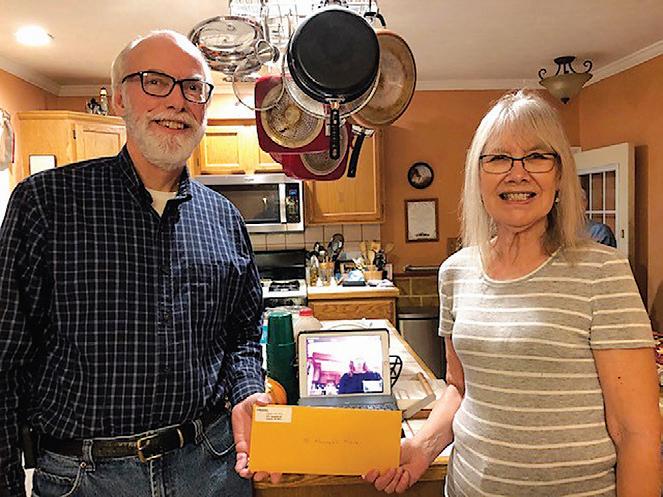
Capital Arbor (MI) put together a Giving and ankful Project for the month of November. e arbor decided to give $1,800 divided among a total of six favorite non-pro t organizations. e donations were made in the form of supermarket gift cards, which were delivered as part of a packet that included a Gleaner insert telling about Capital Arbor. Each also contained a personal note written on Gleaner stationery. Among the recipients were Hannah’s House, a facility for homeless new mothers; the Cristo Rey food bank and food pantry; and Endeavor House, a new home for women recovering from addiction that is in need of furnishings.
Caro Arbor (MI) donated $500 to the local VFW to support its Christmas gift-giving program to the families of veterans. e arbor also purchased Girl Scout cookies that it donated to the homeless shelter for veterans. In December, members wrote out cards of appreciation to area day care centers. Gift cards from a local eatery were purchased and enclosed with the letters to be distributed to the day care centers’ workers. e arbor also nalized donations for the rest of the year, hand delivering them to e Good Samaritan Food Pantry Women’s Assault Crisis Shelter, Senior Dining Services, Community Dog Park and Splash Pad.
Chester Arbor (OH) hosted an impact activity for 4-H members that drew 42 participants on Oct. 25. e students, representing both Marion and Morrow counties, spent the cold afternoon learning how to survive in the outdoors. Speakers covered six areas of interest and taught small groups safety habits, how to build a re, sh, hunt, use material found in nature to survive, and how to identify safe items to eat as well as dangerous ones. Marilyn Weiler, a Gleaner member and a naturalist, planned the activity with her committee. Participants each received a 4-H cloth bag made by Gleaner members and lled with donated or purchased items that would be needed for an adventure in the woods. Members also were encouraged to check out project books and further outdoor projects. e turnout despite worries was encouraging, and involvement of another county’s 4-H members will help plan future activities together.



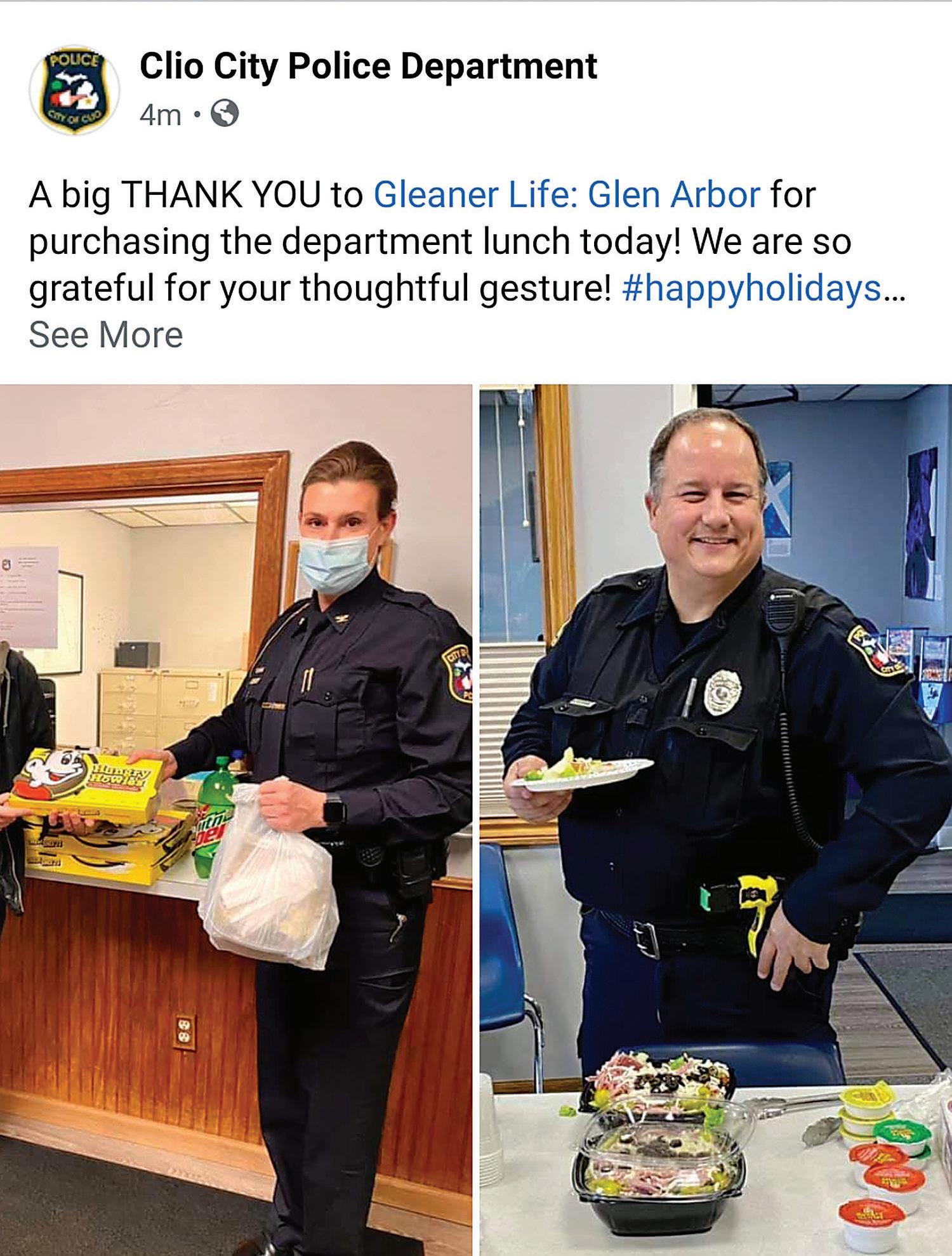
Glen Arbor (MI) worked on several projects in December including a luncheon for the Clio Police Department, “Pay it Forward” projects at both a local restaurant and a grocery store, distribution of di erent gift cards for seniors for Christmas with Gleaner promotional items, three fruit baskets that each included a $25 gift card and popcorn tins for people shut in their homes, the purchase of a new car battery for a community member in need, and approval of a $500 gift for a family in need.
Grand Arbor (MI) worked with volunteers to pack Christmas boxes on Dec. 12. Eight members and 10 guests gathered in a church fellowship center for the packing. ey put placards on each box to let recipients know the food was from the Gleaner arbor, and put cold food in Gleaner insulated totes the arbor had ordered from the Home O ce. As each family came, volunteers brought food out to their vehicles to facilitate social distancing. Each family was appreciative, and the Christmas box was a successful event.
Hawthorne Arbor (IN)
nished up its annual project of recognizing a re department with a donation. is year’s $1,000 recipient was the Shelby Volunteer Fire Department. “We were nally able to present the check now to our recipient for this year,” the arbor reported. e check would normally have been presented at the arbor’s anksgiving dinner to which various groups the arbor supports are invited, but 2020 forced numerous changes. e arbor instead passed out its anksgiving poultry to six food pantries and tried to pass out checks separately.
